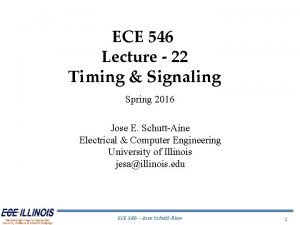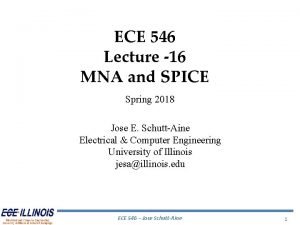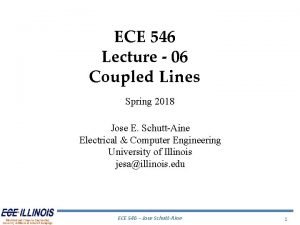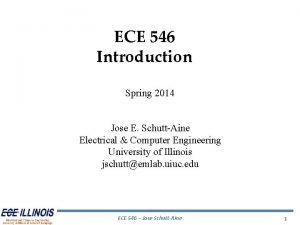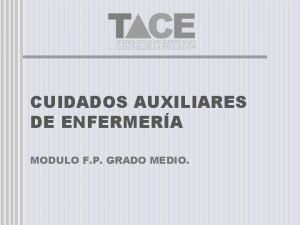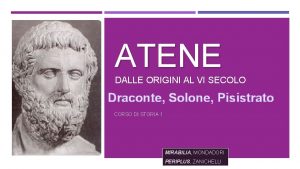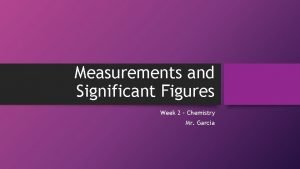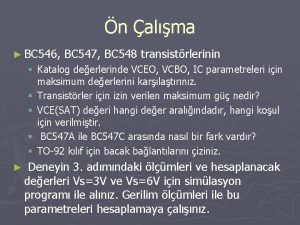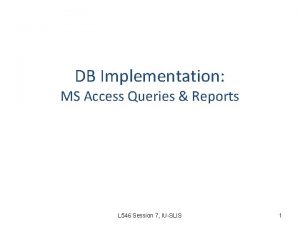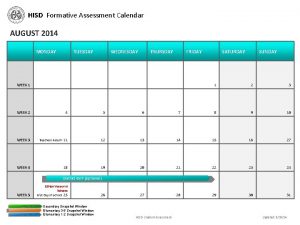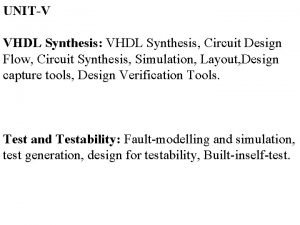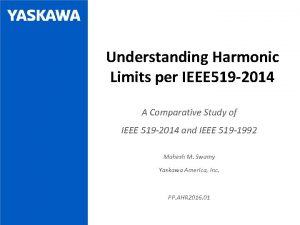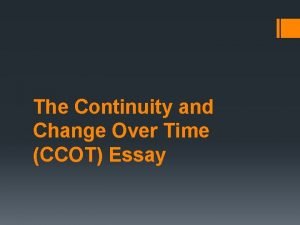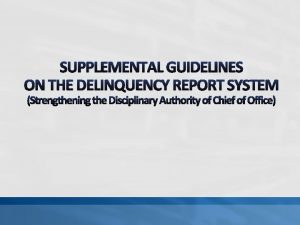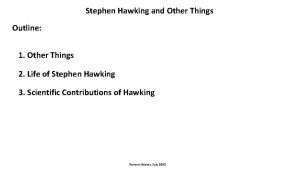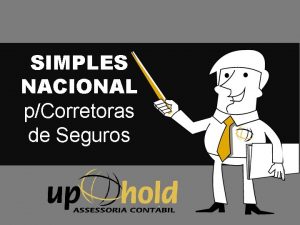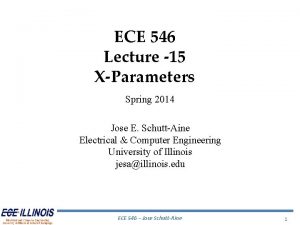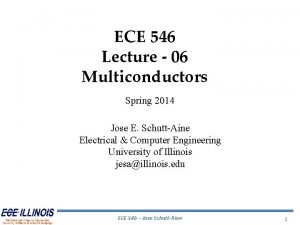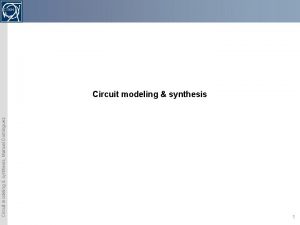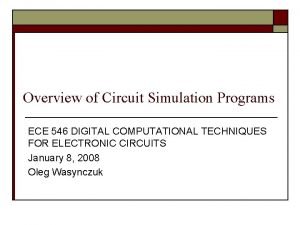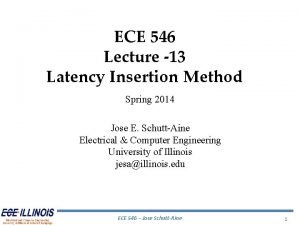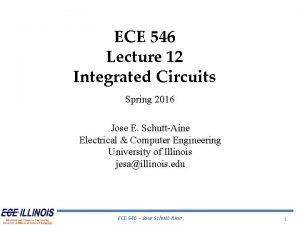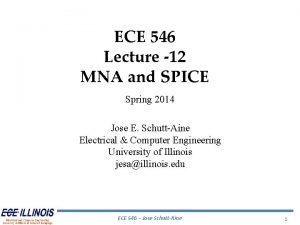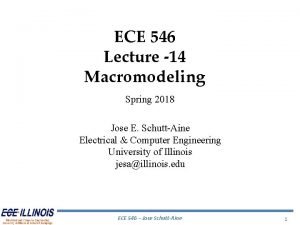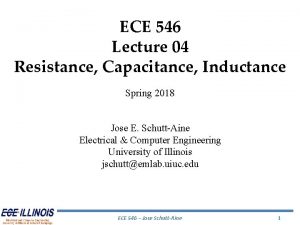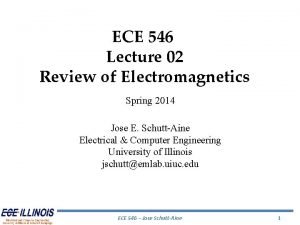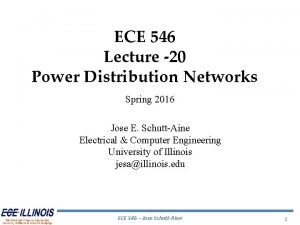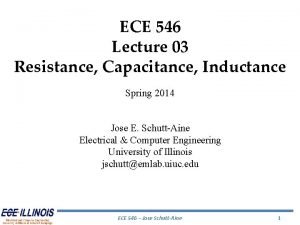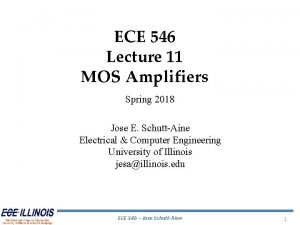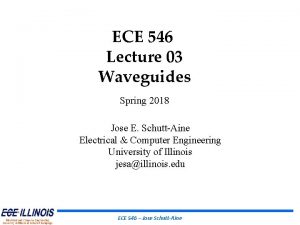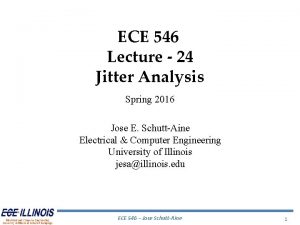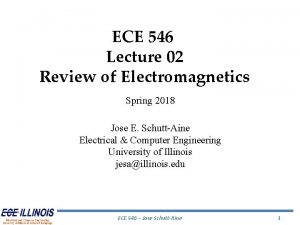ECE 546 Lecture 11 Circuit Synthesis Spring 2014


































- Slides: 34

ECE 546 Lecture -11 Circuit Synthesis Spring 2014 Jose E. Schutt-Aine Electrical & Computer Engineering University of Illinois jesa@illinois. edu ECE 546 – Jose Schutt-Aine 1

MOR via Vector Fitting • Rational function approximation: • Introduce an unknown function σ(s) that satisfies: • Poles of f(s) = zeros of σ(s): • Flip unstable poles into the left half plane. s-domain Im Re ECE 546 – Jose Schutt-Aine 2

Passivity Enforcement • State-space form: • Hamiltonian matrix: • Passive if M has no imaginary eigenvalues. • Sweep: • Quadratic programming: – Minimize (change in response) subject to (passivity compensation). ECE 546 – Jose Schutt-Aine 3/28 3

Macromodel Circuit Synthesis Use of Macromodel • Time-Domain simulation using recursive convolution • Frequency-domain circuit synthesis for SPICE netlist ECE 546 – Jose Schutt-Aine 4

Macromodel Circuit Synthesis Objective: Determine equivalent circuit from macromodel representation* Motivation • Circuit can be used in SPICE Goal • Generate a netlist of circuit elements *Giulio Antonini "SPICE Equivalent Circuits of Frequency. Domain Responses", IEEE Transactions on Electromagnetic Compatibility, pp 502 -512, Vol. 45, No. 3, August 2003. ECE 546 – Jose Schutt-Aine 5

Circuit Realization Circuit realization consists of interfacing the reduced model with a general circuit simulator such as SPICE Model order reduction gives a transfer function that can be presented in matrix form as or ECE 546 – Jose Schutt-Aine 6

Y-Parameter - Circuit Realization Each of the Y-parameters can be represented as where the ak’s are the residues and the pk’s are the poles. d is a constant ECE 546 – Jose Schutt-Aine 7

Y-Parameter - Circuit Realization The realized circuit will have the following topology: We need to determine the circuit elements within yijk ECE 546 – Jose Schutt-Aine 8

Y-Parameter - Circuit Realization We try to find the circuit associated with each term: 1. Constant term d 2. Each pole-residue pair ECE 546 – Jose Schutt-Aine 9

Y-Parameter - Circuit Realization In the pole-residue case, we must distinguish two cases (a) Pole is real (b) Complex conjugate pair of poles In all cases, we must find an equivalent circuit consisting of lumped elements that will exhibit the same behavior ECE 546 – Jose Schutt-Aine 10

Circuit Realization – Constant Term ECE 546 – Jose Schutt-Aine 11

Circuit Realization - Real Pole Consider the circuit shown above. The input impedance Z as a function of the complex frequency s can be expressed as: ECE 546 – Jose Schutt-Aine 12

Circuit Realization - Complex Poles Consider the circuit shown above. The input impedance Z as a function of the complex frequency s can be expressed as: ECE 546 – Jose Schutt-Aine 13

Circuit Realization - Complex Poles ECE 546 – Jose Schutt-Aine 14

Circuit Realization - Complex Poles Each term associated with a complex pole pair in the expansion gives: Where r 1, r 2, p 1 and p 2 are the complex residues and poles. They satisfy: r 1=r 2* and p 1=p 2* It can be re-arranged as: ECE 546 – Jose Schutt-Aine 15

Circuit Realization - Complex Poles We next compare and DEFINE product of poles sum of poles ECE 546 – Jose Schutt-Aine sum of residues cross product 16

Circuit Realization - Complex Poles We can identify the circuit elements ECE 546 – Jose Schutt-Aine 17

Circuit Realization - Complex Poles In the circuit synthesis process, it is possible that some circuit elements come as negative. To prevent this situation, we add a contribution to the real parts of the residues of the system. In the case of a complex residue, for instance, assume that Can show that both augmented and compensation circuits will have positive elements ECE 546 – Jose Schutt-Aine 18

S-Parameter - Circuit Realization Each of the S-parameters can be represented as where the ak’s are the residues and the pk’s are the poles. d is a constant ECE 546 – Jose Schutt-Aine 19

Realization from S-Parameters The realized circuit will have the following topology: We need to determine the circuit elements within sijk ECE 546 – Jose Schutt-Aine 20

S-Parameter - Circuit Realization We try to find the circuit associated with each term: 1. Constant term d 2. Each pole and residue pair ECE 546 – Jose Schutt-Aine 21

S-Parameter - Circuit Realization In the pole-residue case, we must distinguish two cases (a) Pole is real (b) Complex conjugate pair of poles In all cases, we must find an equivalent circuit consisting of lumped elements that will exhibit the same behavior ECE 546 – Jose Schutt-Aine 22

S- Circuit Realization – Constant Term ECE 546 – Jose Schutt-Aine 23

S-Realization – Real Poles ECE 546 – Jose Schutt-Aine 24

S-Realization – Real Poles Admittance of proposed model is given by: ECE 546 – Jose Schutt-Aine 25

S-Realization – Real Poles From S-parameter expansion we have: which corresponds to: where from which ECE 546 – Jose Schutt-Aine 26

Realization – Complex Poles Proposed model which can be re-arranged as: ECE 546 – Jose Schutt-Aine 27

Realization – Complex Poles From the S-parameter expansion, the complex pole pair gives: which corresponds to an admittance of: ECE 546 – Jose Schutt-Aine 28

Realization – Complex Poles The admittance expression can be re-arranged as WE HAD DEFINED product of poles sum of poles ECE 546 – Jose Schutt-Aine sum of residues cross product 29

Realization – Complex Poles Matching the terms with like coefficients gives ECE 546 – Jose Schutt-Aine 30

Realization from S-Parameters Solving gives ECE 546 – Jose Schutt-Aine 31

Typical SPICE Netlist * 32 -pole approximation *This subcircuit has 16 pairs of complex poles and 0 real poles. subckt sample 8000 9000 vsens 8001 8000 8001 0. 0 vsens 9001 9000 9001 0. 0 *subcircuit for s[1][1] *complex residue-pole pairs for k= 1 residue: -6. 4662 e-002 8. 1147 e-002 pole: -4. 4593 e-001 -2. 4048 e+001 elc 1 1 0 8001 0 1. 0 hc 2 2 1 vsens 8001 50. 0 rtersc 3 2 3 50. 0 vp 4 3 4 0. 0 l 1 cd 5 4 5 1. 933 e-007 rocd 5 4 0 5. 000 e+001 r 1 cd 6 5. 895 e+003 c 1 cd 6 6 0 3. 474 e-015 r 2 cd 6 6 0 -9. 682 e+003 : *constant term 2 2 -6. 192 e-003 edee 397 0 9001 0 1. 0 e+000 hdee 398 397 vsens 9001 50. 0 rterdee 399 398 399 50. 0 vp 400 399 400 0. 0 rdee 400 0 49. 4 *current sources fs 4 0 8001 vp 4 -1. 0 gs 4 0 8001 4 0 0. 020 fs 10 0 8001 vp 10 -1. 0 gs 10 0 8001 10 0 0. 020 fs 16 0 8001 vp 16 -1. 0 gs 16 0 8001 16 0 0. 020 fs 22 0 8001 vp 22 -1. 0 gs 22 0 8001 22 0 0. 020 fs 28 0 8001 vp 28 -1. 0 gs 28 0 8001 28 0 0. 020 ECE 546 – Jose Schutt-Aine 32

Realization from Y-Parameters Recursive convolution SPICE realization ECE 546 – Jose Schutt-Aine 33

Realization from S-Parameters Recursive convolution SPICE realization ECE 546 – Jose Schutt-Aine 34
 Ece 546
Ece 546 Ece546
Ece546 Ece 546
Ece 546 Ece 546 uiuc
Ece 546 uiuc Rd 546/95
Rd 546/95 546-528 a.c
546-528 a.c Significant figures of 546 km
Significant figures of 546 km Bc 547
Bc 547 L 546
L 546 Hisd calendar
Hisd calendar 01:640:244 lecture notes - lecture 15: plat, idah, farad
01:640:244 lecture notes - lecture 15: plat, idah, farad Bae yong-kyun
Bae yong-kyun May is summer?
May is summer? Vhdl design flow
Vhdl design flow Voltage in parallel circuit
Voltage in parallel circuit Types of electrical circuits
Types of electrical circuits Phet circuit construction kit
Phet circuit construction kit Parallel vs series
Parallel vs series Difference between complete circuit and incomplete circuit
Difference between complete circuit and incomplete circuit Shorted resistor parallel circuit
Shorted resistor parallel circuit Venn diagram of active and passive voice
Venn diagram of active and passive voice Circulatory system labeled
Circulatory system labeled Advantages of parallel circuit over series circuit
Advantages of parallel circuit over series circuit Teacher twins 2014
Teacher twins 2014 Who traditional medicine strategy 2014–23
Who traditional medicine strategy 2014–23 Teacher twins@2014
Teacher twins@2014 Ddb board regulation #1 s. 2014
Ddb board regulation #1 s. 2014 Ieee 519 harmonic limits
Ieee 519 harmonic limits Continuity and change thesis
Continuity and change thesis Delinquency report system
Delinquency report system Stephen hawking film 2014
Stephen hawking film 2014 2014 special olympics
2014 special olympics Social services and wellbeing act easy read
Social services and wellbeing act easy read Social services and wellbeing (wales) act 2014 easy read
Social services and wellbeing (wales) act 2014 easy read Agosto 2014
Agosto 2014
